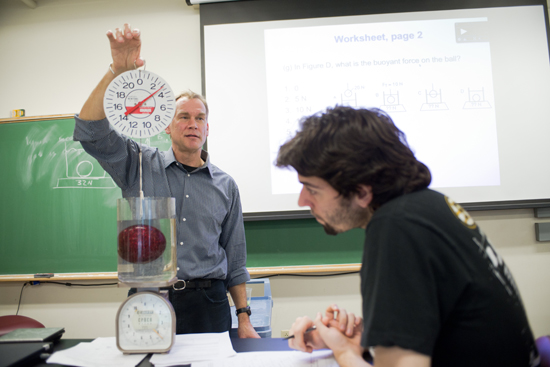Wanted: One Good Physics Teacher
PhysTEC recruits more, and better qualified, science teachers

PhysTEC teacher-in-residence Juliet Jenkins (left) is something of an ambassador for her profession, teaching students and sharing her expertise with professors. Photos by Kalman Zabarsky
Michael Thees wants to rearrange molecular and atomic structures and study what happens. The senior physics major has applied to graduate programs and is waiting on a response. But should Plan A not work out, he has a Plan B: becoming a high school physics teacher.
“I have been known at BU to talk about slipping educational standards—the fact that we don’t educate our students as well as China, Japan, Korea, and Germany,” says Thees (CAS’12). “Part of the blame may or may not lie with teachers. Going into teaching would be part of a solution as opposed to just complaining about it.”
Thees is just the type of student BU hopes to recruit as part of the Physics Teacher Education Coalition (PhysTEC), a program funded by the National Science Foundation, whose primary goal is to recruit and improve the quality of future physics and physical science teachers. BU is the first university in the region to take part in PhysTEC, which has 19 other participating colleges nationwide.
The NSF will fund the program’s first three years at BU with $100,000 annually. The Provost’s Office, the College of Arts & Sciences physics department, and the School of Education have agreed to fund it for the following three years, at an annual cost of $90,000.
The United States faces a critical shortage of qualified physics and physical science teachers, according to PhysTEC. Two-thirds of new physics teachers do not have a degree in physics, and more than 90 percent of middle school physical science students are taught by teachers who have neither a physical science major nor science certification.

Currently, only one out of 50 BU physics majors during a two-year period chooses teaching over graduate school or the private sector, according to Bennett Goldberg, a CAS physics professor and former department chair, who helped apply for the PhysTEC grant. He wants to see that number increase to five or six students each year.
PhysTEC requires close collaboration between SED and the physics department. SED already offers a two-credit course for science majors that provides an introduction to pedagogy and an opportunity to visit urban classrooms, where they can observe high school physics, chemistry, and biology teachers at work. The school also offers biology, chemistry, and physics undergrads a learning assistant course where they can aid BU professors in their fields. And this semester SED and the physics department announced a joint undergraduate degree targeting future physics teachers.
“Our objective is to try to make it as easy as possible for physics and science majors to have an opportunity teaching in the schools and perhaps going on to earn a teaching certification,” says Peter Garik, an SED clinical associate professor and PhysTEC co–principal investigator.
As part of the PhysTEC program, BU has hired a high school physics teacher-in-residence. The first person to hold that position, Newton-based Juliet Jenkins has taken graduate courses in Improving the Teaching of Physics, a BU and University of Massachusetts Boston program for science teachers to become more proficient in physics concepts and teaching methods.
As teacher-in-residence, Jenkins is something of an ambassador for her profession. She speaks to introductory science classes and clubs, telling students about the critical shortage of physics teachers and the rewards of being in the classroom. She also helps teach the SED learning assistant course and an urban education experience course and hosts BU’s Teacher Advisory Group, where local physics teachers network and share their best practices with University physics professors.
“High school teachers are more at the forefront of curriculum reform and teaching innovation,” Jenkins says. “That is their profession. At the university level, you’re hired or fired on your publications.” She hopes to share her expertise with professors to encourage more student-centered learning.

While about a third of the faculty is open to such changes, Goldberg says, most professors see their primary responsibility as training the next generation of physicists, not high school teachers. He would like to see a cultural shift in the department toward more interactive exercises that hook students on the art of teaching.
Andrew Duffy falls within that minority. A CAS master lecturer and the PhysTEC principal investigator, he has taught undergraduate physics courses for years in an interactive style. On a recent Monday in his Elementary Physics 2 course, he flashed a problem on a projector screen and started a one-minute timer, asking students to solve it and vote, anonymously, for the correct answer. Hands shot up toward the screen as students pushed their votes into palm-sized devices. When the time had expired, a graph popped up showing how the vote had split.
As a teacher, Duffy finds the exchange effective: “They give you feedback on what they don’t understand.”
Goldberg and other colleagues teach a pilot Physics 1 studio course that merges lecture, discussion, and lab. The move is a shift away from traditional pure lecture classes. More studio classrooms will be built by next fall, Goldberg says, to accommodate this teaching style.
PhysTEC is not meant to dissuade physics students wanting to go into research and hold faculty positions. Rather, Jenkins says, it’s designed for science lovers who might enjoy that “do-good component” of teaching and get a little high when they see someone “get it.”
“It’s what’s made my career,” says Jenkins.
For more information about PhysTEC, email Juliet Jenkins, call her at 617-358-6729, or visit her office at 3 Cummington St., PRB 357.
Comments & Discussion
Boston University moderates comments to facilitate an informed, substantive, civil conversation. Abusive, profane, self-promotional, misleading, incoherent or off-topic comments will be rejected. Moderators are staffed during regular business hours (EST) and can only accept comments written in English. Statistics or facts must include a citation or a link to the citation.